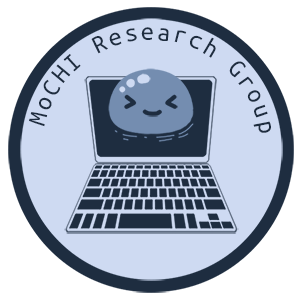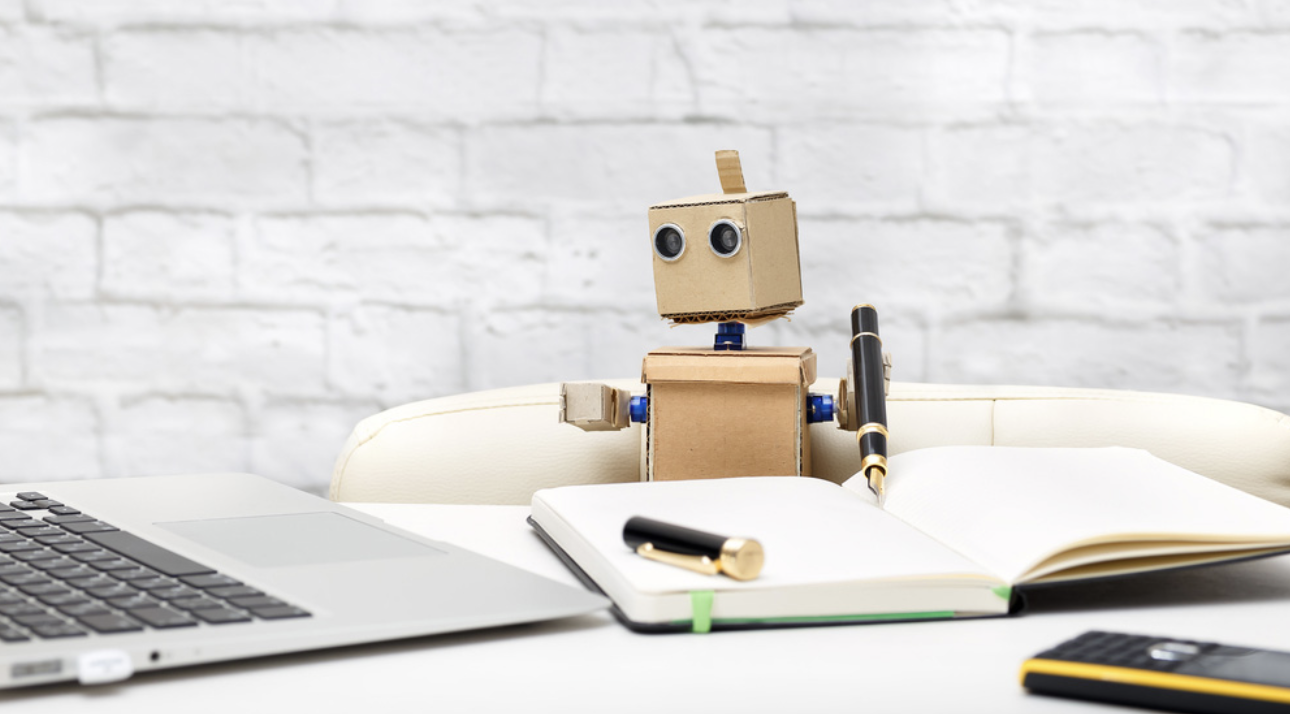Last updated on June 5, 2023
On May 2nd writers throughout the US went on strike after the Alliance of Motion Picture and Television Producers refused to meet the minimum demands of the Writers Guild of America (WGA) in the negotiations for their contract renewal [1]. The primary demands of the WGA are fairer compensation and fewer mini-rooms (sessions of up to 10 weeks during which a few writers are paid very little and tasked with creating the script for the first several episodes of a show which may not even be created) [2]. While these issues may be the core motivation behind the strike, there is a third issue prevalent in the recent protests: Could their jobs be replaced by artificial intelligence?
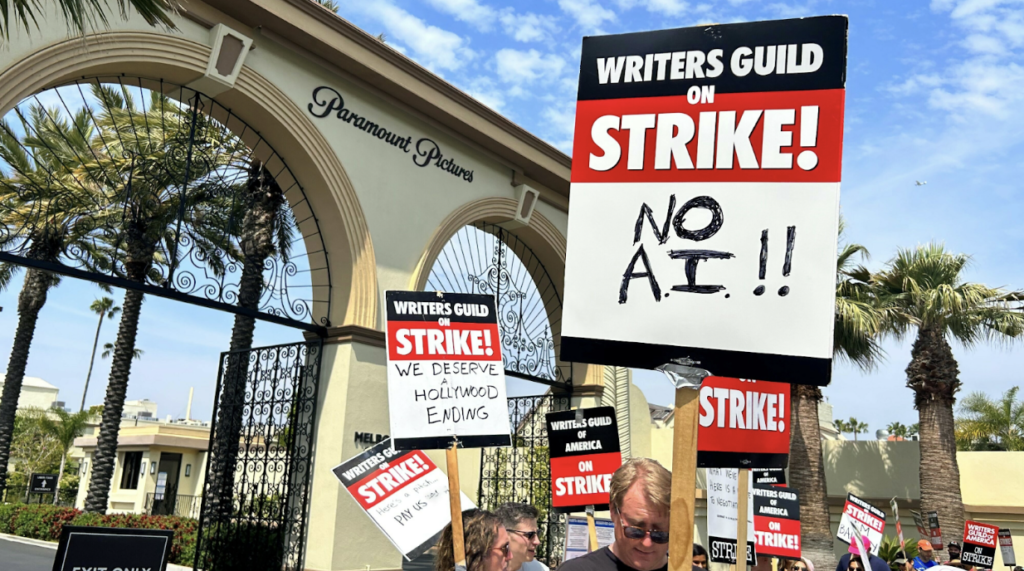
Image Source: [3]
How will AI Change the Job Market?
The growing popularity of AI spurred on by the widespread use of OpenAI’s ChatGPT has several writers expressing concerns that writing will become obsolete or only as editors of AI-written scripts [3]. This anxiety is shared by people in many other professions as well [4]. For several careers, this is a valid concern as little is certain about the future capabilities of AI. Job cuts are projected for industries in which the core value of the job is manual organization; in the finance industry, for instance, bank tellers and back-office supporting jobs are expected to be replaced by AI in the coming years [5]. Other jobs will see an increase in efficiency which in some cases will keep a steady number of jobs while in others, where the demand is not high enough, job cuts can also be expected. In 2020 The World Economic Forum predicted that AI will replace 85 million jobs globally by 2025 [6]. This shift will affect different industries to different extents. A Goldman Sachs report predicts 46% of administrative support, 44% of legal work, and 37% of architecture and engineering can be automated. As opposed to 6% of construction work, 4% of maintenance, and 1% of building and ground cleaning on the other end of the spectrum; the average for the US is just under 25% [7].
However, like with all technology, AI is expected to create jobs, not just replace them. The same World Economic Forum report predicts that AI may create 97 million new jobs [6]. Plus, the accuracy and speed with which AI can perform certain tasks serve to create all sorts of new benefits for both companies and consumers. For instance, UPS recently began implementing an AI to map routes which have decreased delivery times, spending, and their carbon footprint [6].
Technological Revolutions
In 2023, AI seems new and futuristic to most of the population. It is a development that few are entirely comfortable with and even fewer understand. It is easy to view AI as entirely unique in its power to change society, but in doing so we forget the impact of other technologies we have grown comfortable with. Uneasy feelings towards the newest technological advancement have been seen countless times throughout history. In 16th-century Europe, the invention of the printing press caused people to worry about the spread of misinformation through mass-produced pamphlets [8]. The Scribe Guild was a medieval group that, much like modern-day unions, protected the rights and interests of its workers who transcribed books and other writings. This guild smashed printing machines and intimidated printers out of fear that their jobs were being replaced [8]. In the end, the printing press created new jobs in industries like printing, publishing, and journalism. These new jobs used the printing press to bring society affordable novels, textbooks, and newspapers among other goods improving people’s way of life. In the 19th century, the steam engine was invented to power trains and factories. In reaction to this development, a group called the Luddites united in opposition to technology. The Luddites rioted, destroyed steam-powered machines, and spread their fears that their jobs such as weaving, sewing, and other types of artisan trades were being replaced by factory work [9]. Yet again, the steam engine created all sorts of new jobs in the management of and work in factories as well as the railroad industry. It also gave consumers more affordable products and new luxuries. A century later, the creation of computers was met with trepidation, bringing about the term computerphobia, popular in the media to describe people who were worried about the effect computers would have on society [10]. In the 80s and 90s; factory workers, switchboard operators, as well as several clerks and bank tellers, lost their jobs to computers, and yet imagine the jobs and industries today that would not exist without the computer (like a computer science research group for instance!). The printing press, steam engine, and computer are considered the three greatest technological revolutions that changed the job market forever. Each revolution came with its own fears of job loss, but each ended up creating more jobs than it took away.
Technology and the Arts
Writing requires creativity and the three inventions mentioned above mainly replace manual work, not creative work. AI writing is considerably more experimental at this time than AI art, so it may help to explore trends in the intersection between technology and art. Consider the camera. Charles Baudelaire was a 19th-century artist who in his essay The Daguerreotype argued: “If photography is allowed to deputize for art in some of art’s activities, it will not be long before it has supplanted or corrupted art altogether, thanks to the stupidity of the masses, its natural ally” [11]. As we’ve discussed it is no surprise that several artists feared the invention of photography. However, the camera opened a world of possibilities for artists. It drove a phasing out of realism, and it became a tool for artists’ expression in photography and in things like collages and photo editing, all of which are respected practices in the art world today [12]. Baudelaire’s concerns seem strikingly similar to those modern artists have regarding AI-generated art. Critics imagine a dystopian replacement of artists by machine-made art lacking in emotion and creativity. This lack of emotion and creativity is precisely why AI is not likely to make artists obsolete. However, like photography, we will likely continue to see AI being used as a tool for the artist to create what they otherwise would be incapable of [12]. The camera catalyzed impressionism [13] so perhaps, AI art may serve as an encouragement for artists to adapt and create new and different types of art. Refik Anadol is a digital artist whose installation “Machine Hallucination” uses a StyleGan – a generative AI created by, tech company, NVIDIA – to create a shifting landscape of art from millions of pictures of New York City [14]. The speed at which a computer can generate content opens new doors for artists seeking to create interactive or infinitely changing art.
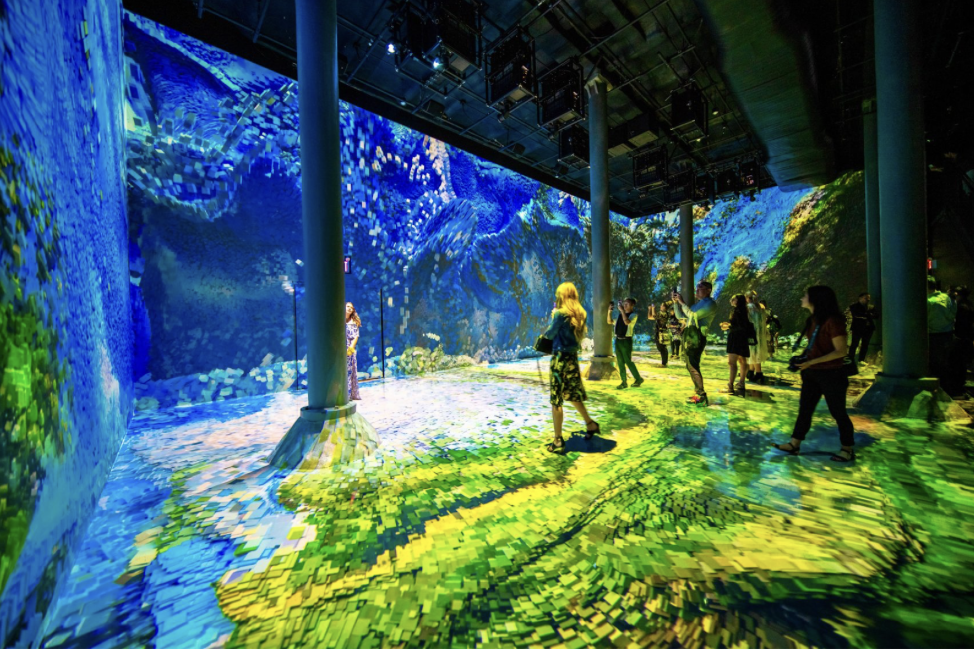
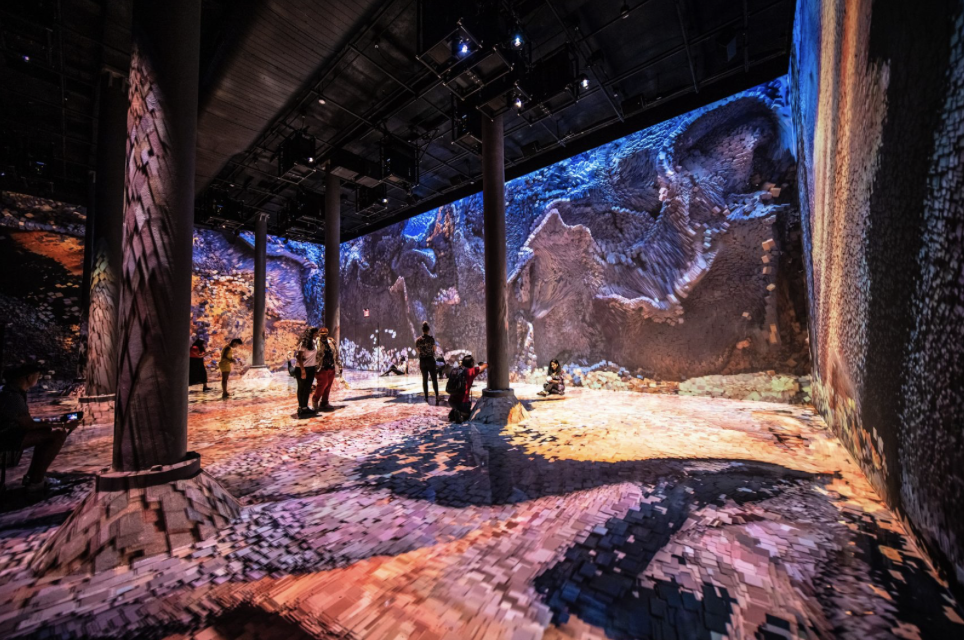
Image Source: [16]
Plagiarism and Compensation
It is clear from historical trends that artists will continue to be valuable contributors to society as AI becomes more capable. Perhaps the bigger concern is whether their value will be reflected in their compensation. AI in the fields of art and writing uses databases of existing works to generate new content, and it presents this content as original, raising the moral dilemma of ownership. This January three artists sued DeviantArt, Stability AI, and Midjourney, three of the top AI art generators in Andersen et al v. Stability AI et al alleging that the use of their artwork in the AIs’ databases was an infringement on their copyrights [15]. After all, it is human art that allows AI art to have the qualities it does [16]. Unfortunately, this is a difficult argument to support since the database is so large, it is impossible to track exactly which artists had their work used with no compensation or recognition [15]. If companies replace artists in less experimental subsections of art which AI is better suited for such as product design, artists stand to lose income despite the continued use of their collective work in AI databases. This replacement could result in unfair distribution of money as the owners of these companies would spend less on art at the expense of artists who they pay nothing [16]. In this scenario, without adequate compensation, the body of new work created by artists expands at a far slower pace. In a world where artists universally receive stable incomes or have their needs met, AI poses no threat because artists would be free to continue to create and contribute to society [16]. This concern with AI is ultimately a concern with the social and economic structures in place which were designed in and for a world without AI, and perhaps those structures need to be modified if AI is to create progress without damaging peoples’ livelihoods and widening the wage gap.
The Future of AI in Writing
AI writing also raises these concerns regarding plagiarism. Any work written by AI, even a more advanced one that hasn’t been developed yet, will rely on a huge database of works created by human writers. If a work produced in this manner is effective, entertaining, or emotional it will be because these qualities were present in human work. A work created by AI may have value as an amalgamation of human experiences and ideas, so perhaps AI writing can have a place in media so long as writers are somehow fairly compensated for the use of their writings.
Furthermore, like artists, writers can use AI as a valuable tool to experiment with, improve on, or speed up their work. For example, Matt Nix, the writer of the TV show True Lies says he uses the AI software “Pickaxe” as a brainstorming assistant when coming up with new episodes. He explains that while the first round of suggestions are typically cliché, the algorithm can be pushed with further instruction to produce more unique ideas to inspire episodes [3]. The creator of “Pickaxe” Mike Gioia describes his perspective on how AI can be used in writing: “I see it’s the creatives that are actually getting more empowered because you still need a creative mind. You need taste. You need to know what makes interesting drama, and interesting characters, what makes a story good, what makes it human. And that sensibility is not coming from the studio heads” [3]. Just imagine the possibilities for interactive stories when you combine the emotion, knowledge, and experience of writers with the speed and real-time generation of AI. The representatives of the WGA understand this value of AI. They have made it clear that they are not “anti-technology” and do not want to ban AI completely [17]. Currently, the concern held by WGA is its use with greed, without adequate compensation to writers [17]. Given compensation in the ideal economic structure, writers would not only be fairly valued, but they would be free to continue to write and create content which can be used both on its own and as a part of AI databases to assist in the creation of art by other writers.
In summary, it would seem that AI writing can coexist with writers in a way that makes the jobs of writers easier, allows for the production of more content, and creates potential for new forms of media. On the other hand, the concerns surrounding AI expressed by writers in the recent strike are not entirely unfounded. If the adequate systems for compensation are not implemented writers will suffer, and AI databases will obtain less new content to work with. As in previous technological revolutions, the social and economic systems in place need time to adapt to progress. Until those adaptations are made, problems associated with the newest technology are inevitable. Recall that the industrial revolution magnified economic imbalance, but that this imbalance led to things like unions and minimum wages to regulate factory labor. Similarly, the widespread use of AI will instill the need for its own set of regulations. Ultimately, AI is here to stay, whether this is for better or worse will come down to the socio-economic decisions made around its implementation.
References
- https://www.facebook.com/peoplemag, “Late-Night Shows Shut Down as Hollywood Writers Strike Begins After Failed Negotiations,” Peoplemag. https://people.com/tv/late-night-shows-to-shutdown-as-hollywood-writers-strike-begins-after-failed-negotiations/ (accessed Jun. 05, 2023).
- J. M. O. Schneider, J. Maas, J. Otterson, and M. Schneider, “One of the Writers Guild’s Biggest Contract Negotiation Issues Is the ‘Mini Room’ Boom,” Variety, Mar. 29, 2023. https://variety.com/2023/tv/news/writers-guild-contract-negotiation-mini-room-1235568173/
- “Striking Hollywood scribes ponder AI in the writer’s room,” NPR, May 18, 2023. https://www.npr.org/2023/05/18/1176876301/striking-hollywood-writers-contemplate-ai
- S. Kiderlin, “Artificial Intelligence is booming – but how will it impact your career?,” CNBC, Feb. 20, 2023.
- H. David et al., “The Impact of Artificial Intelligence (AI) on the Financial Job Market.” Boston Consulting Group, 2018.
- “The Impact of AI on the Job Market and the Future of Work,” Intellect Data, Feb. 23, 2023. https://intellectdata.com/the-impact-of-ai-on-the-job-market-and-the-future-of-work/ (accessed Jun. 05, 2023).
- S. Kiderlin, “Goldman Sachs says generative A.I. could impact 300 million jobs — here’s which ones,” CNBC, Mar. 28, 2023. https://www.cnbc.com/2023/03/28/ai-automation-could-impact-300-million-jobs-heres-which-ones.html
- “People destroyed printing presses out of fear. What will we do to AI?,” Big Think, Apr. 06, 2023. https://bigthink.com/the-past/printing-press-ai/ (accessed Jun. 05, 2023).
- M. Muhleisen, “The Impact of Digital Technology on Society and Economic Growth – IMF F&D Magazine – June 2018 | Volume 55 | Number 2,” IMF, Jun. 2018. https://www.imf.org/en/Publications/fandd/issues/2018/06/impact-of-digital-technology-on-economic-growth-muhleisen
- A. LaFrance, “When People Feared Computers,” The Atlantic, Mar. 30, 2015. https://www.theatlantic.com/technology/archive/2015/03/when-people-feared-computers/388919/
- C. Baudelaire, “The Daguerreotype,” in Classic Essays on Photography, A. Trachtenberg, Ed. New Haven, CT: Leete’s Island Books, 1980.
- B. Ciftci, “Why some artists see AI-generated art as a threat to their livelihood,” Medium, Mar. 14, 2023. https://bootcamp.uxdesign.cc/why-some-artists-see-ai-generated-art-as-a-threat-to-their-livelihood-f4634b24a5ce
- E. Silva, “How Photography Pioneered a New Understanding of Art,” TheCollector, Jun. 04, 2022. https://www.thecollector.com/how-photography-transformed-art/
- “Refik Anadol uses AI to create mesmerizing film of New York City,” Dezeen, Nov. 20, 2019. https://www.dezeen.com/2019/11/20/machine-hallucination-artechouse-refik-anadol-new-york/
- B. Brittain and B. Brittain, “AI companies ask U.S. court to dismiss artists’ copyright lawsuit,” Reuters, Apr. 19, 2023. Available: https://www.reuters.com/legal/ai-companies-ask-us-court-dismiss-artists-copyright-lawsuit-2023-04-19/
- K. Yup, “What AI art means for society, according to Yale experts,” Yale Daily News, Jan. 23, 2023. https://yaledailynews.com/blog/2023/01/23/what-ai-art-means-for-society-according-to-yale-experts/
- D. Feldman, “The Hollywood Writers’ Strike: 3 Reasons Not To Back Down On AI,” Forbes. https://www.forbes.com/sites/danafeldman/2023/05/24/the-hollywood-writers-strike-3-reasons-not-to-back-down-on-ai/?sh=7af591163955 (accessed Jun. 05, 2023).
- C. Hamilton, “Now You Can Get an AI to Write for You,” Techonomy, Oct. 28, 2022. https://techonomy.com/now-you-can-get-an-ai-to-write-for-you/ (accessed Jun. 05, 2023).
Featured Image: [18]
